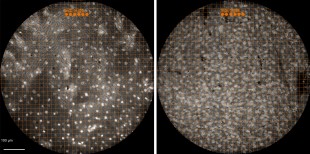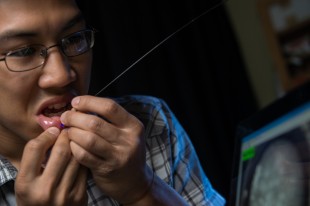David Ruth
713-348-6327
david@rice.edu
Jade Boyd
713-348-6778
jadeboyd@rice.edu
Study: Microendoscope could eliminate unneeded biopsies
Rice University device nearly doubled sensitivity of esophageal cancer screenings
HOUSTON — (June 1, 2015) — In a clinical study of patients in the United States and China, researchers found that a low-cost, portable, battery-powered microendoscope developed by Rice University bioengineers could eventually eliminate the need for costly biopsies for many patients undergoing standard endoscopic screening for esophageal cancer.

Rice University bioengineer Rebecca Richards-Kortum holds a fiber-optic cable attached to the microendoscope that could eliminate the need for costly biopsies for many patients undergoing standard endoscopic screening for esophageal cancer.
The research is available online in the journal Gastroenterology and was co-authored by researchers from nearly a dozen institutions that include Rice, Baylor College of Medicine, the Chinese Academy of Medical Sciences and the National Cancer Institute.
The clinical study, which involved 147 U.S. and Chinese patients undergoing examination for potentially malignant squamous cell tumors, explored whether Rice’s low-cost, high-resolution fiber-optic imaging system could reduce the need for unnecessary biopsies when used in combination with a conventional endoscope — the worldwide standard of care for esophageal cancer diagnoses.
The study involved patients from two U.S. and two Chinese hospitals: Mt. Sinai Medical Center in New York, the University of Texas MD Anderson Cancer Center in Houston, the Cancer Institute and Hospital of the Chinese Academy of Medical Sciences in Beijing and First University Hospital in Jilin, China.
In the study, all 147 patients with suspect lesions were examined with both a traditional endoscope and Rice’s microendoscope. Biopsies were obtained based upon the results of the traditional endoscopic exam.

In these images from Rice's high-resolution microendoscope, the white spots are cell nuclei, which are irregularly shaped and enlarged in cancerous tumors (right) as compared with healthy tissue (left). Credit: Richards-Kortum Lab/Rice University
A pathology exam revealed that more than half of those receiving biopsies — 58 percent — did not have high-grade precancer or cancer. The researchers found that the microendoscopic exam could have spared unnecessary biopsies for about 90 percent of the patients with benign lesions.
“For patients, biopsies are stressful and sometimes painful,” said lead researcher Rebecca Richards-Kortum, Rice’s Stanley C. Moore Professor of Bioengineering, professor of electrical and computer engineering and director of Rice 360°: Institute for Global Health Technologies. “In addition, in low-resource settings, pathology costs frequently exceed endoscopy costs. So the microendoscope could both improve patient outcomes and provide a significant cost-saving advantage if used in conjunction with a traditional endoscope.”
When examined under a microscope, cancerous and precancerous cells typically appear different from healthy cells. The study of cellular structures is known as histology, and a histological analysis is typically required for an accurate diagnosis of both the type and stage of a cancerous tumor.

Dr. Sharmila Anandasabapathy, professor of medicine and gastroenterology at Baylor College of Medicine and director of Baylor Global Initiatives and the Baylor Global Innovation Center. Credit: Baylor College of Medicine
To determine whether a biopsy is needed for a histological exam, health professionals often use endoscopes, small cameras mounted on flexible tubes that can be inserted into the body to visually examine an organ or tissue without surgery. Rice’s high-resolution microendoscope uses a 1-millimeter-wide fiber-optic cable that is attached to the standard endoscope. The cable transmits images to a high-powered fluorescence microscope, and the endoscopist uses a tablet computer to view the microscope’s output. The microendoscope provides images with similar resolution to traditional histology and allows endoscopists to see individual cells and cell nuclei in lesions suspected of being cancerous.
By providing real-time histological data to endoscopists, Rice’s microendoscope can help rule out malignancy in cases that would otherwise require a biopsy.
“While traditional endoscopy can rule out malignancy and eliminate the need for biopsies for some patients, in a significant number of cases the difference between malignant and benign lesions only becomes apparent through a histological analysis,” said study co-author Dr. Sharmila Anandasabapathy, professor of medicine and gastroenterology at Baylor College of Medicine and director of Baylor Global Initiatives and the Baylor Global Innovation Center.

Timothy Quang, a Rice University bioengineering graduate student, demonstrates a microendoscope that could eliminate the need for costly biopsies for many patients undergoing standard endoscopic screening for esophageal cancer. Credit: Jeff Fitlow/Rice University
Richards-Kortum’s lab specializes in the development of low-cost optical imaging and spectroscopy tools to detect cancer and infectious disease at the point of care. Her research group is particularly interested in developing technology for low-resource settings, and the microendoscope was developed as part of that effort. It is battery-operated, inexpensive to operate and requires very little training. Results from the clinical study verified that both experienced and novice endoscopists could use the microendoscope to make accurate assessments of the need for a biopsy.
Clinical studies of Rice’s microendoscope are either planned or underway for a dozen types of cancer including cervical, bladder, oral and colon cancers.
“More than half of cancer deaths today occur in the developing world, often in low-resource areas,” Anandasabapathy said. “The World Health Organization and other important international bodies have called for increased global focus on noncommunicable diseases like cancer, and Rice’s microendoscope is a great example of what the right kind of technology can do to change health care in low-resource countries.”
Additional study co-authors include Timothy Quang, Dongsuk Shin and Richard Schwarz, all of Rice; James Godbold, Marion-Anna Protano, Michelle Lee, Josephine Mitcham, Erin Moshier, Alexandros Polydorides and Courtney Hudson, all of Mount Sinai Medical Center; Junsheng Cui, Hong Xu, Fan Zhang and Weiran Xum, all of the First Hospital of Jilin University; Guiqi Wang and Liyan Xue of the Cancer Institute and Hospital, Chinese Academy of Medical Sciences; Sanford Dawsey of the National Cancer Institute; Mark Pierce of Rutgers University; Manoop Bhutani of the University of Texas MD Anderson Cancer Center; Neil Parikh of Yale University; and Chin Hur of Massachusetts General Hospital.
The research was supported by the National Cancer Institute.
-30-
VIDEO is available at:
High-resolution IMAGES are available for download at:
https://news2.rice.edu/files/2015/05/0601_HRME-1-web.jpg
CAPTION: In these images from Rice’s high-resolution microendoscope (HRME), the white spots are cell nuclei, which are irregularly shaped and enlarged in cancerous tumors (right) as compared with healthy tissue (left).
CREDIT: Richards-Kortum Lab/Rice University
https://news2.rice.edu/files/2015/05/0601_HRME-2-web.jpg
CAPTION: Dr. Sharmila Anandasabapathy, professor of medicine and gastroenterology at Baylor College of Medicine and director of Baylor Global Initiatives and the Baylor Global Innovation Center.
CREDIT: Baylor College of Medicine
https://news2.rice.edu/files/2015/05/0601_HRME-3-web.jpg
CAPTION: Timothy Quang, a Rice University bioengineering graduate student, demonstrates a microendoscope that could eliminate the need for costly biopsies for many patients undergoing standard endoscopic screening for esophageal cancer.
CREDIT: Jeff Fitlow/Rice University
https://news2.rice.edu/files/2015/05/0601_HRME-5-web.jpg
CAPTION: Rice University bioengineer Rebecca Richards-Kortum holds a fiber-optic cable attached to the microendoscope that could eliminate the need for costly biopsies for many patients undergoing standard endoscopic screening for esophageal cancer.
CREDIT: Jeff Fitlow/Rice University
A copy of the paper, “Low-Cost High-Resolution Microendoscopy for the Detection of Esophageal Squamous Cell Neoplasia: An International, Multicenter Trial,” is available at:
http://www.gastrojournal.org/article/S0016-5085(15)00675-7/abstract
This release can be found online at news-network.rice.edu/news.
Follow Rice News and Media Relations via Twitter @RiceUNews
Located on a 300-acre forested campus in Houston, Rice University is consistently ranked among the nation’s top 20 universities by U.S. News & World Report. Rice has highly respected schools of Architecture, Business, Continuing Studies, Engineering, Humanities, Music, Natural Sciences and Social Sciences and is home to the Baker Institute for Public Policy. With 3,888 undergraduates and 2,610 graduate students, Rice’s undergraduate student-to-faculty ratio is just over 6-to-1. Its residential college system builds close-knit communities and lifelong friendships, just one reason why Rice is highly ranked for best quality of life by the Princeton Review and for best value among private universities by Kiplinger’s Personal Finance. To read “What they’re saying about Rice,” go here.

